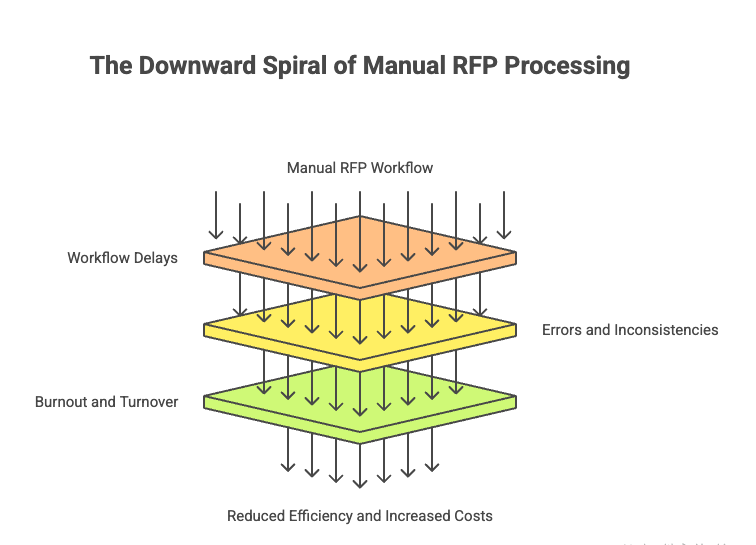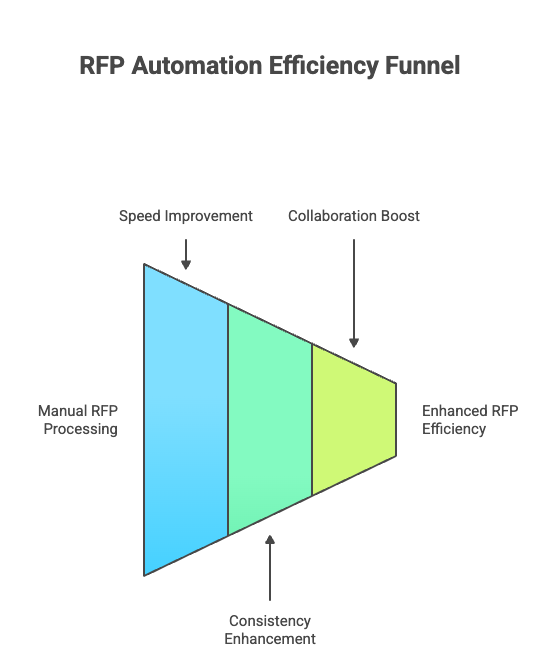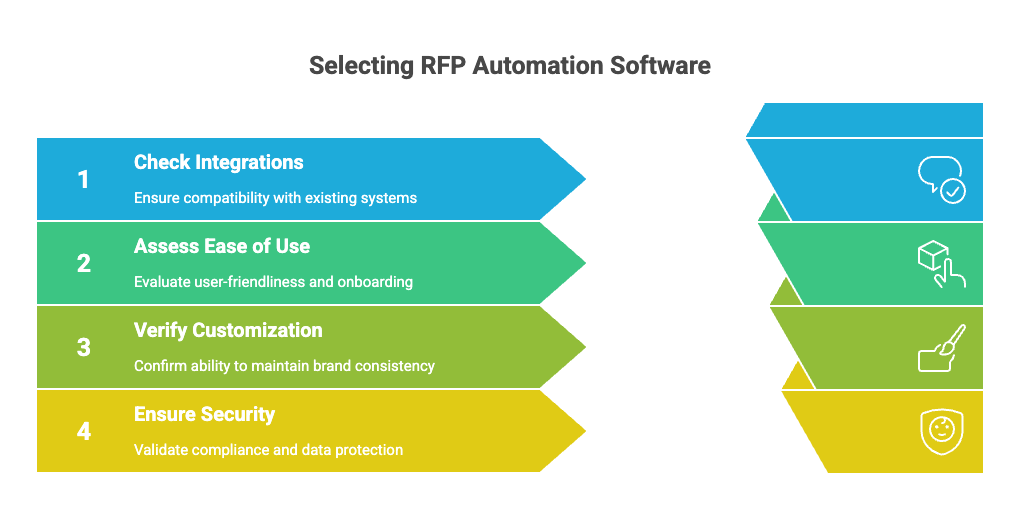Manual vs Automated RFP Processing: Real Costs & ROI Compared
Article written by
Kate Williams

INSIDE THE ARTICLE
SHARE THIS ARTICLE
Summary
The article discusses the transition from manual to automated RFP (Request for Proposal) processes, highlighting the significant benefits of automation, including time savings, improved accuracy, enhanced collaboration, and increased proposal output. It emphasizes that organizations implementing RFP automation systems can achieve better outcomes and reduce inefficiencies inherent in manual processes.
Did you know that sales and proposal teams lose more time and money than they realize when they handle RFPs manually? A single response can swallow 20–61 hours of effort and nearly $5,000 in labor, and most of that work never feels strategic. However, automated RFP processing transforms the process by accelerating cycles, enhancing accuracy, and increasing win rates without increasing the workforce. This blog unpacks the real difference between both approaches and why automation has become the new baseline for efficient, competitive proposal teams.
What Are the Real Costs of Manual RFP Processing?
Manual RFP processing often looks harmless on the surface, but the inefficiencies run deeper than what most teams see day-to-day. While the obvious labor hours are easy to calculate, the hidden costs—missed revenue, compliance risks, inconsistent content, and employee burnout—quietly accumulate and weaken your competitive position over time.
Missed Opportunities from Delayed Responses
Manual RFP workflows slow teams down at every step. Companies fail to complete nearly 20% of RFPs simply because manual processes can’t keep up with the volume. These missed submissions translate into hundreds of thousands—sometimes millions—in lost revenue.
Competitors using automated RFP management tools respond faster, maintain consistency, and reach the buyer well before teams still stuck in spreadsheets. In manual workflows, bottlenecks appear everywhere: slow document intake, scattered content files, delayed SME reviews, and endless formatting tasks. While your team is catching up, rivals are already shortlisted.
Human Errors and Compliance Risks
Manual RFP responses leave plenty of room for costly mistakes. A single typo—like entering “50” instead of “500”—can derail pricing tables, violate regulatory guidelines, or misrepresent security requirements. These small errors have high consequences:
- Immediate disqualification from the RFP
- Compliance penalties ranging from $10,000 to $1M
- Loss of trust with potential clients
Because manual compliance checks are inconsistent, companies relying on them often pay 2x higher compliance costs than teams using automated RFP software. Regulators also take note when underwriting guidelines or policy statements differ from one submission to another—something automated systems prevent through standardized, approved content.
Inconsistent Messaging Across Teams
Without a centralized RFP knowledge base, teams unknowingly submit conflicting answers across proposals. One RFP response says “Yes,” another says “It depends,” and a third uses outdated language from last year’s security policy. These inconsistencies create confusion and diminish credibility with evaluators.
Centralized RFP software improves technical accuracy by 34%, ensuring every submission is aligned, current, and trustworthy. Consistent messaging is one of the strongest predictors of a successful RFP outcome.
Employee Burnout from Repetitive Tasks
Manual RFP processing doesn’t just drain time—it drains people. Proposal teams often work nights and weekends chasing reviewers, fixing formatting, and rewriting the same content from scratch. No surprise that 8 in 10 proposal professionals report burnout or stress related to manual RFP management.
Burnout leads to lower productivity, higher error rates, and eventually turnover. When key contributors leave, the organization loses institutional knowledge and pays heavily to replace them—costs that automation helps prevent by removing repetitive, low-value work.
Financial Impact: Manual vs Automated RFP Processing
When comparing manual vs automated RFP workflows, the financial differences become hard to ignore. Labor, missed revenue, compliance penalties, and turnover drive up the cost of manual RFP processing far more than organizations expect.
Labor Costs: $5,000+ Per Manual RFP
A typical five-person team spending ~20 hours each per RFP at $50/hour results in over $5,000 in direct labor cost per response. And this doesn’t count the time wasted searching for content, fixing errors, or chasing approvals.
These hours could instead be spent prospecting, engaging buyers, or advancing revenue opportunities. For organizations responding to dozens of RFPs per year, manual processing becomes one of the most expensive line items in the sales workflow.
Lost Revenue from Missed Deadlines
Companies using automated RFP software report 43% higher win rates because they deliver complete, compliant responses faster and more consistently. Manual teams not only submit fewer RFPs—they lose deals they could have won.
Research shows that failing to complete ~20% of RFPs results in annual losses of hundreds of thousands to over $3 million for mid-sized and enterprise organizations. Manual delays aren’t just operational flaws, they directly impact revenue.
Legal and Compliance Penalties
Manual RFP responses are at greater risk of including outdated or incorrect information. In regulated industries, compliance mistakes can trigger fines from $10,000 to $1M, damage long-term trust, and expose the company to legal challenges.
Automated RFP management tools reduce this risk by ensuring every response is pulled from approved, up-to-date content with automated validation layers built in.
Turnover Costs from Low Morale
Manual RFP processes contribute to high turnover because repetitive work drains morale. Companies with inefficient proposal workflows see 20% higher churn, and replacing even one employee costs between 33% and 200% of their annual salary.
For a $60K employee, that’s $30K–$120K lost each time someone leaves. Automation alleviates workload pressure, reduces stress, and stabilizes teams—ultimately lowering HR and recruiting costs.
The financial case for automated RFP software becomes clear fast. When you add labor savings, higher win rates, reduced compliance exposure, and lower turnover, most organizations recoup their automation investment in months, not years.

What Is Automated RFP Processing?
Automated RFP management is a technology-driven approach that streamlines the entire RFP response process, from document intake and requirement mapping to drafting, reviews, approvals, and submission. Instead of relying on emails, spreadsheets, and scattered files, automation uses AI, centralized knowledge bases, and real-time collaboration to handle repetitive work and keep teams aligned. This allows organizations to respond to complex RFPs faster, with higher accuracy and far less manual effort.
Modern automated RFP platforms such as SparrowGenie extract questions automatically, recommend the best answers from approved content, and generate first drafts within minutes. Built-in workflows route tasks to the right owners, track deadlines, and flag inconsistencies before they become risks. By replacing manual steps with governed, intelligent automation, companies can reduce turnaround times by 40–70%, improve response quality, and take on more RFPs without increasing team size.
How Does RFP Automation Improve Efficiency?
Efficiency gains from RFP automation don’t come from one big feature; they come from several small but powerful changes that reshape how teams work. When manual steps disappear and information becomes easier to access, proposal cycles speed up naturally. Automation creates a workflow where people spend less time hunting for content and more time improving the quality of the response. Here's how automation enhances efficiency:
Response Time Reduction: 40–70% Faster
RFP automation dramatically accelerates the response cycle. Teams that automate their RFP workflow typically see a 40–70% reduction in turnaround time because tasks that used to take days, like breaking down long documents or assembling first drafts, now take hours. AI-driven mapping and automated content suggestions remove much of the manual prep work, and companies shifting from legacy systems regularly report 60% faster output, with first-time adopters seeing improvements closer to 80%. Faster cycles mean your team can respond to more RFPs without increasing headcount, expanding total revenue capacity.
Centralized Knowledge Base for Instant Access
Automated RFP software replaces scattered files, old folders, and email hunts with a unified knowledge base. All approved, up-to-date answers live in one structured library, giving teams instant access to accurate content. Instead of rewriting core sections from scratch, proposal teams reuse vetted material and spend their time on customization rather than re-creation. This consistency raises response quality, reduces compliance risk, and ensures every proposal carries the same level of accuracy and professionalism.
AI-Powered Suggestions for Faster Drafting
Modern automated RFP management platforms use AI to analyze requirements and generate structured first drafts within minutes. These systems can identify winning patterns from past proposals, recommend tailored content for each question, and automatically fill responses using relevant data from your knowledge base. Rather than starting from zero, proposal teams begin with a strong, contextual draft and focus their efforts on refinement, personalization, and strategic messaging; improving both speed and quality at the same time.
Real-Time Collaboration Across Departments
Automated RFP tools eliminate version chaos by giving Sales, Legal, Finance, Security, and Compliance one shared workspace. Multiple stakeholders can review, comment, and approve sections simultaneously, with every update visible in real time. This live collaboration cuts down bottlenecks, shortens review cycles, and helps teams stay on track. Organizations using real-time collaboration are 40% more likely to submit RFPs on time, and their proposals typically score higher due to stronger cross-functional alignment.
Together, these improvements create a more efficient, predictable, and scalable RFP process, one that helps teams respond faster, reduce errors, and consistently deliver higher-quality proposals.

What ROI Can You Expect from RFP Automation?
The data paints a clear picture as we dissect manual vs automated RFP systems. Let's look beyond theory and explore the actual returns organizations see after implementing RFP automation software.
Win Rate Improvement: 43% Higher with Automation
Organizations that shift from manual RFP processing to automated RFP management consistently see a 43% increase in win rates. Faster turnaround, stronger consistency, and higher-quality responses give teams a measurable competitive edge. Many companies report success rates rising from ~30% to 50–70% after adopting automated RFP software—an improvement that directly boosts revenue without requiring additional resources or changes in pricing strategy.
Cost Savings from Reduced Admin Overhead
Automated RFP systems significantly reduce operational waste by removing repetitive, low-value tasks. According to Forrester’s TEI reports, companies gain $3.10 million in efficiency improvements over three years from shifts like:
- 50% lower cost per RFP response
- Staff reallocation and reduced labor overhead (saving $270,900 over three years)
- Dramatic decline in overtime and weekend work
- Fewer delays, fewer revisions, and fewer errors
When admin work shrinks, teams recover meaningful time for higher-impact activities like prospecting, discovery, and value messaging.
Scalability Without Increasing Headcount
RFP volume typically grows as a company expands, and manual teams struggle to keep up. Automated RFP management enables organizations to handle this growth without hiring additional staff. By year three, most teams complete 25% more RFPs annually, generating new revenue opportunities worth $2.5 million or more. Automation builds sustainable capacity that manual processes simply cannot support.
Evidence-Based Insights for Continuous Improvement
Automated RFP platforms offer analytics that manual workflows can’t replicate. With visibility into win rates, content usage, response accuracy, and bottlenecks, teams can continuously refine their RFP strategy. These insights help organizations:
- Identify which responses win most often
- Adjust workflows based on completion data
- Improve proposal quality with performance trends
- Strengthen consistency across teams
This data-driven approach compounds over time, turning RFP management into a strategic advantage.
When combined with higher win rates, lower admin costs, scalable capacity, and data-driven refinement, automated RFP software delivers a powerful financial return. Most organizations see a dramatic ROI within months, with a three-year impact of 415% ROI and a net present value of $4.74M, making automation one of the most profitable operational upgrades available.
How Do You Choose the Right RFP Automation Software?
Selecting the right RFP automation platform becomes much easier when you know what actually impacts day-to-day proposal work. Instead of getting distracted by long feature lists, focus on the core capabilities that determine how smoothly your team can collaborate, customize responses, and keep sensitive data protected. The right tool should feel like an engine that lifts the workload—not another system to manage.
1. Strong Integrations
A good RFP platform should plug effortlessly into your existing ecosystem. That means connecting with CRMs like Salesforce or HubSpot, syncing with document systems such as SharePoint or Google Drive, and supporting the collaboration tools your teams already rely on. When integrations work properly, data flows freely, duplicate work disappears, and every stakeholder sees the latest version without hunting for files.
2. Easy to Use and Adopt
Even the most powerful software fails if people struggle to use it. Look for clean dashboards, intuitive navigation, and a layout that makes sense on day one. Strong onboarding and in-app guidance help teams get productive faster, and a simple interface encourages participation from non-technical contributors. The easier the tool is to use, the faster it becomes part of your everyday proposal rhythm.
3. Flexible Customization Options
Your proposals should feel consistent, polished, and on-brand. That’s why you need a platform with flexible templates, reusable content blocks, and a centralized library for approved messaging. When customization is easy, teams can adapt responses for each buyer without sacrificing consistency. The end result is a refined proposal package that feels intentional and aligned to your identity.
4. Enterprise-Grade Security
Because RFPs often include financials, architectural diagrams, and security documentation, the software must offer enterprise-level protection. Look for SOC 2 compliance, encryption, MFA, SSO, and role-based access controls.
Together, these features ensure sensitive information stays protected, internal approvals stay governed, and compliance remains intact, even as multiple teams collaborate in the same workspace. When you evaluate platforms through the lens of integrations, usability, customization, and security, the right choice becomes clearer.
A good RFP automation software should reduce friction, elevate the quality of every submission, and give teams confidence that their process is structured and secure. With the right tool in place, your proposal workflow becomes faster, more accurate, and far more scalable.

Manual vs Automated RFP Processing: What’s the Difference?
Before teams can decide whether automation is worth the investment, it helps to see both methods side by side. The differences go far beyond speed; manual workflows slow teams down in ways that impact accuracy, collaboration, completion rates, and even morale. Laying the two approaches next to each other makes the trade-offs impossible to ignore.
Category | Manual | Automated |
|---|---|---|
Time per RFP | 20–61 hours | 40–70% faster |
Cost per RFP | ~$5,000 | ~50% lower |
Win Rates | Baseline | +43% higher |
Completion Rates | Miss ~20% | +25% more completed |
Team Health | High burnout | Reduced stress |
Error Risk | High | Automated checks |
Knowledge | Scattered | Centralized |
Compliance | 2× costs | Built-in validation |
ROI | N/A | 415% over 3 years |
Collaboration | Siloed | Real-time |
These statistics and findings come directly from our research data.*
When you look at the numbers together, the gap becomes hard to argue with. Manual processes require significant time, labor, and ongoing problem-solving, whereas automated systems provide speed, consistency, and measurable revenue impact. This comparison isn’t just theoretical; it reflects what happens inside real teams every day, and it’s why so many organizations are making automation their default RFP strategy.
Conclusion
Manual RFP processing drains time, money, and team morale, often without teams realizing the true cost. Automated RFP systems like SparrowGenie change that trajectory by accelerating response cycles, reducing errors, increasing consistency, and improving win rates by 43% or more. With a 415% three-year ROI and the capability to scale without adding extra headcount, automation transforms RFPs from a stressful obligation into a predictable growth channel. As competition increases and buyers expect faster, cleaner responses, adopting a modern RFP automation platform becomes a smart, future-proof move for any B2B organization.
Ready to see how AI can transform your RFP process?
Product Marketing Manager at SurveySparrow
A writer by heart, and a marketer by trade with a passion to excel! I strive by the motto "Something New, Everyday"
Frequently Asked Questions (FAQs)
Related Articles

RFP Project Management: Your Guide to Winning More Proposals

What is Sales Content Management? A Definitive Guide 2026
